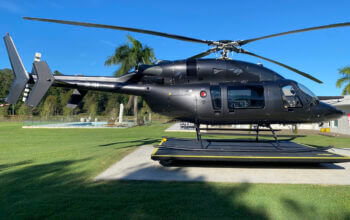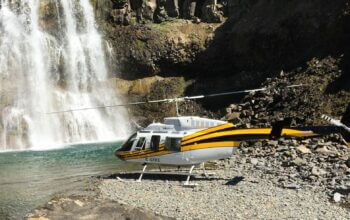Lilium has released new footage of its all-electric Lilium Jet in flight as it prepares to move the program into high-speed flight testing.
The footage revealed on Tuesday shows the five-seat, full-scale eVTOL prototype transitioning from a hover into forward flight, and flying around its home airport in Oberpfaffenhofen, Germany, at speeds of up to 100 kilometers per hour (62 miles per hour). The video release marks the conclusion of the remotely piloted aircraft’s first phase of flight testing, less than six months after it made its first, tentative hover. Lilium will now gradually expand the prototype’s flight envelope up to its target speed of 300 km/h (186 mph), a process that is expected to take the better part of a year.
“Really what we think we’ve achieved is [we’ve] proven the controllability of the aircraft and its responsiveness to the inputs that we want, and everything’s gone broadly according to plan,” Lilium head of communications Oliver Walker-Jones told eVTOL.com. “Now that we’ve proven all of the basic maneuvers of the aircraft, we’ll introduce increasing amounts of speed . . . so we’ll start to see the aircraft moving faster and faster.”
Reaching those higher speeds is critical to Lilium’s business model. The company is not only an aircraft developer, it also plans to operate fleets of Lilium Jets through its own commercial air taxi service. And, unlike eVTOL developers such as Volocopter — which is focused squarely on inner-city missions — Lilium is pursuing a more regional mobility model, connecting destinations as far as 300 kilometers apart.

That’s an ambitious target, and the company acknowledges it still has much to prove. However, Walker-Jones said that early indications are promising. He explained that first-phase test flights have rarely exceeded 10 minutes due simply to the incremental nature of Lilium’s approach: “Every time we fly, we do basically one more thing than we’ve done before. . . . We successfully perform a task and we land again.” Nevertheless, he continued, the team has been pleasantly surprised by the performance of the aircraft’s lithium-ion batteries and is “not concerned about battery endurance at all,” particularly given the expected efficiency of the winged aircraft in cruise flight.
“We’re very confident that the battery actually is performing super well for us at the moment, so that’s not a limiting factor,” he said. “I think that will just be one of those ‘proof is in the pudding’ [things] over the next 12 months or so. We will show that and people will hopefully be wowed.”
In addition to expanding the flight envelope, Lilium has also been conducting a variety of safety tests both on the ground and in the air. These include fuse-blow tests, and failures of individual engines and flaps. (The Lilium Jet gets its propulsion from 36 ducted fans, evenly divided across 12 independently articulating flaps.)
“Those safety tests have worked in the same way that the flight envelope expansion has, in that we start with the very basics and we introduce increasingly more complex failures,” Walker-Jones said. “We’re now up to the point where we’ve successfully dealt with one whole flap failure, which is three engines.”

Walker-Jones said that all flight testing with this prototype will be remotely piloted, as will be much of the flight testing on future prototypes. “We don’t want to do [crewed flight testing] until we have to do it, because obviously the lowest-risk version of flight testing involves not having humans on [board],” he said.
Notably absent from Lilium’s video release was any accompanying aircraft sound. That’s significant, because most industry observers agree that low noise levels will be critical for public acceptance of eVTOL aircraft. Walker-Jones said the absence of sound was not a deliberate attempt to conceal the aircraft’s noise profile, but instead related to the difficulty of compiling a truly representative soundtrack from multiple distributed cameras. The company plans to share representative noise samples in the near future, he said.
Along with the update on the flight program, Lilium announced two other significant developments on Tuesday: the launch of construction on a second manufacturing facility at its headquarters near Munich, and the hiring of Airbus veteran Yves Yemsi as chief program officer.
The new manufacturing facility will be adjacent to Lilium’s existing 3,000-square-meter (32,300-square-foot) hangar at the Oberpfaffenhofen airport. Lilium said the additional, much larger facility will support the production of hundreds of aircraft per year by the time the company launches commercial service, as it aims to do by 2025.

According to co-founder and CEO Daniel Wiegand, “Our ambition is to develop a world-class production facility here that will allow us to build critical parts ourselves and then deliver fully assembled aircraft at the scale of the automotive sector but at the extremely high quality levels required in the aerospace sector.” Wiegand said that Lilium opted to keep the facility at its headquarters thanks to the strength of the local aerospace supply chain. The Munich area is also rich in automotive manufacturing expertise, with BMW and other car makers having production facilities nearby.
“We’re in a part of the world that really knows what it’s doing when it comes to this kind of stuff,” Walker-Jones pointed out. “So I think there’s lots to learn and we’ll be taking people from those businesses, I’m sure, to help us learn.”
Meanwhile, Yemsi, who will oversee the Lilium Jet program and lead strategic procurement activities for the company, brings “a great pedigree of delivering quality within aerospace,” Walker-Jones said. Yemsi most recently served as senior vice president of procurement for Airbus’s Defence and Space division, and was also head of program quality for the Airbus A350. He joins another Airbus veteran — chief manufacturing officer Dirk Gebser, who previously led the assembly of Airbus’s A380 and A320 models — on Lilium’s senior leadership team.
With more than 350 employees including such top-tier talent, Lilium is clearly serious about what it’s doing. The company has already attracted more than $100 million in funding from investors including Atomico, Tencent, LGT, Freigeist, and Obvious Ventures. Earlier this month, TechCrunch reported that the company is seeking to raise between $400 million and $500 million in another round of funding — which is generally considered to be a more realistic ballpark cost for a small aircraft certification program (some programs cost even more).
Lilium declined to comment on the TechCrunch report. However, Walker-Jones said it’s fair to assume that achieving certification and market entry will require additional funding.
“We consider ourselves to be very well capitalized, so there’s no immediate problem with cash. We think we’re in a strong position,” he told eVTOL.com. “But we have a really good set of investors behind us and we think that we will continue to attract other investors, and we speak to them from time to time.”









Love the look of the airplane
Would love to interact with the founders and the masterminds behind this beautiful concept and prototype
Amazing amazing amazing
I think this is the most attractive VTOL design going — but there are a lot of unfulfilled promises here.
* No flight test info released since Oct. 2019
* No indication of continued flight testing at lilium.com
* No release of sound levels
* No info about new prototypes built since last year’s fire (Feb 2020)
* No news of progress on the larger Munich factory started two years ago.
It’s almost as though Lilium stalled in the fall of 2019; their media page cites some new business partnerships and new hires, but there have been no releases dealing with progress in technology, product development, for flight testing.